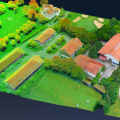
Multi-GNSS Asia (MGA) and the Japanese Aerospace Exploration Agency (JAXA) have just announced a call for EOI to host one of JAXA's multi-GNSS receivers.
These multi-GNSS receivers will be able to track GPS, Glonass, Galileo and QZSS satellite signals. This call is the first step in the establishment of a global continuous observation network for multi-GNSS constellations, and is being coordinated with the International GNSS Service (IGS). The IGS will shortly announce its own call for participation in a global multi-GNSS experiment (M-GEX) by organisations wishing to operate a receiver and to provide observation data files to the IGS and other researchers.
The MGA/JAXA multi-GNSS monitor network (MGM-net) will be established in two phases.
The first phase is to be completed by March 2012, with the deployment of up to 20 specially-modified Javad multi-GNSS in the Asia-Oceania region to track the Quasi-Zenith Satellite (QZS), and to provide data for improved orbit determination and satellite clock error estimation. This AO component of the MGM-Net will support the MGA demonstration campaign, e.g. by being able to test Precise Point Positioning (PPP), including the dissemination of PPP data in real-time via the special "LEX" downlink signal transmitted by JAXA's QZS.
The second phase is to be completed by March 2013 and will involve the deployment of an additional 40 multi-GNSS receivers to sites around the world. This second phase will be coordinated with the IGS's M-GEX.
All RINEX data files collected by the M-GEX and MGM-Net will be made available without cost or constraints to the global community. Real-time data streams will also be able to be accessed, but initially only by participants in the MGM-Net.
See http://www.satnavi.jaxa.jp/e/news/qz-1106012_e.html for further details.







